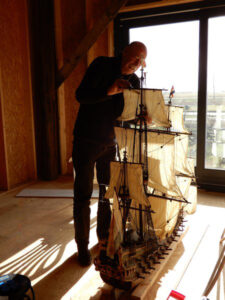The origin
of
Witsen Shipbuilding
Ab Hoving (head of the Restoration Department of Marine Models at the Rijksmuseum, Amsterdam, from 1989 to 2012) built a model of Witsen’s example ship in the 1980s. As a result of the extensive study required before and during its construction, this led to unique knowledge of 17th-century Dutch shipbuilding methods. In 1994, he published the translated information from Witsen, both in text and images, in the book Nicolaes Witsens Scheeps-Bouw-Konst Open Gestelt, published by Van Wijnen Publishing in Franeker. In 2012, the English translation (by Alan Lemmers) was released under the title Nicolaes Witsen and Shipbuilding in the Dutch Golden Age, published by A&M University Press in College Station, Texas.

In 2006, the idea arose to create a virtual pinas, which was only realized in 2016, thanks to the indispensable help of Rene Hendrickx and the free-to-download shipbuilding program Delftship (https://www.delftship.net/downloads/) created by Martijn van Engeland. In a unique collaboration, each part of the ship was virtually designed over the course of three and a half years by Rene, based on Witsen’s texts and measurements.
After initial attempts by students from NHL Hogeschool in Leeuwarden commissioned by the Cultural Heritage Agency of the Netherlands, the archaeological presentation bureau Tijdlab succeeded in creating a digital version of the pinas that is usable for the public.


Maritime heritage encompasses all heritage related to water, both underwater and on land. This heritage includes not only shipwrecks but also ports, quays, bridges, waterways, and even warehouses. Additionally, complete submerged landscapes with prehistoric remains or medieval settlements are found underwater. These finds are often extremely well preserved.
The policy in the Netherlands regarding underwater archaeology is the same as that for archaeology on land. Municipalities play an important role by considering archaeology in the waterbed in their zoning plans.
Part of the RCE
The government, as the owner and manager of many large bodies of water and as the initiator of significant projects for rivers and at sea, plays an important role in the care of maritime heritage. The role of the Cultural Heritage Agency includes issuing permits, advising other authorities, and developing knowledge products. The agency also works internationally to ensure responsible management of Dutch maritime heritage on a global scale.
The Maritime Heritage Netherlands program is committed to managing Dutch cultural maritime heritage from 2018 to 2021, focusing on knowledge, research, policy, collaboration, and education related to underwater archaeology.


